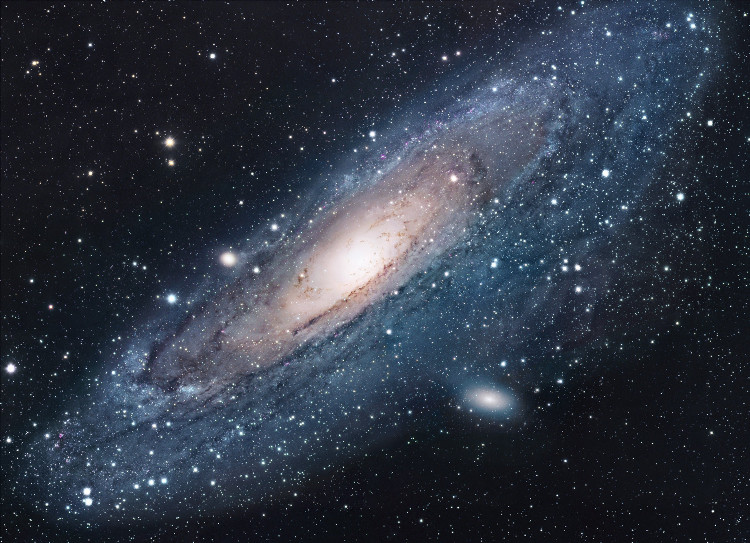The Milky Way has a mass of 700 billion times the Sun.
The most accurate measurement conducted by Canadian scientists shows the total mass of stars, black holes, dust, dark matter and unspecified flying objects of the Milky Way range of 700 billion times that of the Sun.
According to previous data from standard measurements for large celestial bodies, the Milky Way has a mass of 1,000 billion times the Sun. Scientists began calculating Earth's mass two centuries ago and determined the distance from the Earth to the Sun. Later, using Newton's equation, they found that the Sun's mass was 330,000 times the mass of the Earth.
But the Milky Way is more difficult to calculate. In order to make relatively accurate estimates, astronomers must be sure of the speed of objects far away. In addition, only a portion of the Milky Way can be observed through a telescope.

Dark matter can account for 88% of the Milky Way's mass.(Photo: NASA).
"We see everything from the position and movement of the Sun in the Milky Way. It is important that we measure the motion and position of other celestial bodies based on the motion and position of the Sun. years, astronomers put a lot of effort into figuring out how to calculate the Milky Way mass , " Guardian quoted Gwendolyn Eadie, a graduate student at McMaster University in Ontario, Canada, the study's lead author. .
Eadie and Professor William Harris, astronomers and physicists at McMaster University have come up with a way to estimate the mass of galaxies to allow calculations to become more feasible. They published the study at the annual meeting of the Canadian Astronomical Society on May 31 in Winnipeg.
The study provides a deeper understanding of dark matter , an invisible mass that cannot be touched but acts as a binding agent in every galaxy. Until now, scientists have yet to find dark matter.
According to Eadie, the mass of dark matter in the galaxy plays an important role in the galaxy's formation and evolution . Some characteristics such as star formation speed and super black hole size depend on the mass of galaxies.
Eadie said the new method helps estimate the total physical mass in every distance from the galaxy center. The Milky Way is about 100-120 million light-years long. Compare measurements and results of better calculation conditions and more accurate modeling of the Milky Way. After comparing the estimated total mass with the amount of tangible material, the team determined dark matter accounted for about 88% of the Milky Way's mass.
- The mass of the Milky Way
- Decipher the mysterious fog in the Milky Way
- The supernova is 20 times brighter than the Milky Way
- Fun little-known facts about the Milky Way
- The galaxy glows brightly when it produces 4,500 times more stars than the Milky Way
- The Milky Way has billions of planets close to Earth
- 100 billion planets reside in the Milky Way
- Detecting the minimum mass of the galaxy
- Enjoy the pure Milky Way season
- The galaxy cluster is 500 billion billion times heavier than the Sun.
- The mysterious age of the mysterious star
- Close up of the Milky Way's
 Van Allen's belt and evidence that the Apollo 11 mission to the Moon was myth
Van Allen's belt and evidence that the Apollo 11 mission to the Moon was myth The levels of civilization in the universe (Kardashev scale)
The levels of civilization in the universe (Kardashev scale) Today Mars, the sun and the Earth are aligned
Today Mars, the sun and the Earth are aligned The Amazon owner announced a secret plan to build a space base for thousands of people
The Amazon owner announced a secret plan to build a space base for thousands of people How do astronauts weigh when floating in space?
How do astronauts weigh when floating in space?  1g of salt dissolved in 1g of water, why is the total mass not 2g?
1g of salt dissolved in 1g of water, why is the total mass not 2g?  Why is Jupiter not considered a star?
Why is Jupiter not considered a star?  Mass graves in Peru reveal dozens of women living and dying with weaving?
Mass graves in Peru reveal dozens of women living and dying with weaving?  New breakthrough in black hole research helps find 'missing link' in the universe's 10 billion year history
New breakthrough in black hole research helps find 'missing link' in the universe's 10 billion year history  How do scientists measure the mass of a star?
How do scientists measure the mass of a star? 